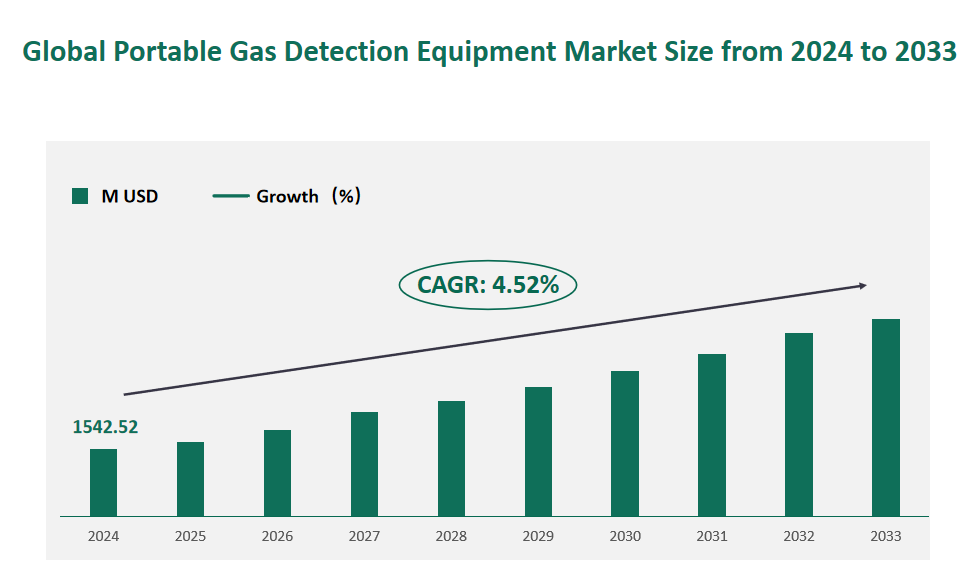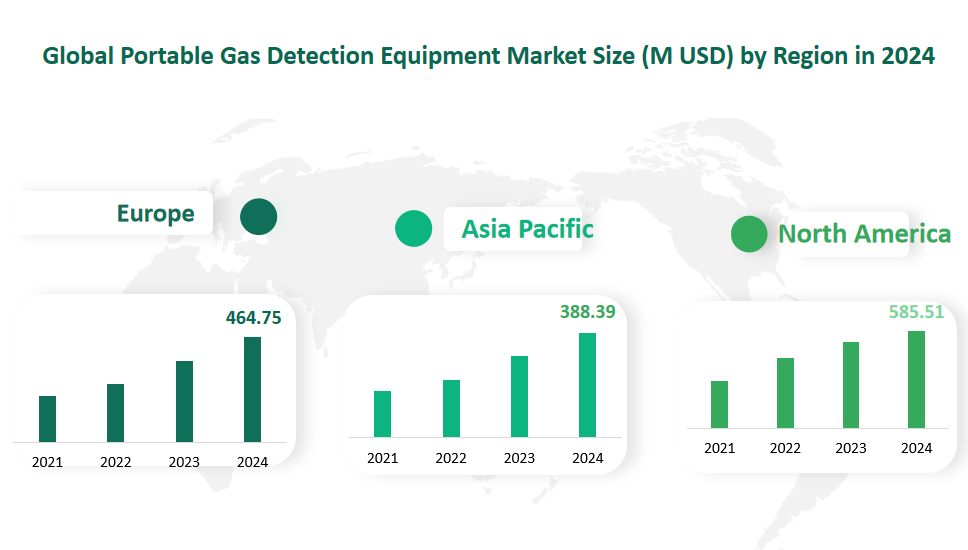1 Global Portable Gas Detection Equipment Market Size (Value) and CAGR (2024-2033)
In 2024, the global Portable Gas Detection Equipment market was valued at USD 1542.52 million, with a CAGR of 4.52% from 2024 to 2033.
Portable gas detection equipment offers precise, reliable and multifunctional measurement of harmful gases. The portable gas detectors are used for diverse applications like personal workplace monitoring, clearance measurement of confined spaces, leakage detection, area monitoring and many more.
Figure Global Portable Gas Detection Equipment Market Size (M USD) and CAGR 2024-2033

2 Portable Gas Detection Equipment Market SWOT Analysis
Strengths
The market’s strengths are primarily driven by the increasing demand from downstream industries. According to the International Energy Agency (IEA), the global demand for natural gas is forecast to grow at an average rate of 1.6% over the next five years, with emerging Asian markets being the main driver. This growth is particularly evident in China, where the “Blue Skies” policy and efforts to improve air quality are boosting gas consumption in the chemical and manufacturing sectors.
Weaknesses
Despite its strengths, the market faces several weaknesses. One significant challenge is the fluctuation of raw material prices, particularly for sensors, which are the most critical components of portable gas detection equipment. The cost of raw materials accounts for a large proportion of the total production cost, and any price volatility can directly impact the profitability of manufacturers.
Opportunities
The market presents several opportunities for growth and expansion. The rapid development of e-commerce and the convenience of online sales have reduced transaction costs and improved business management for manufacturers. Online platforms allow for real-time updates, better customer engagement, and enhanced satisfaction. Technological progress also brings new opportunities, with innovations such as catalytic bead detectors, infrared gas detectors, and compact electrochemical sensors offering improved performance and reliability. These advancements can attract more customers and expand the market’s reach.
Threats
The market also faces several threats that could hinder its growth. The fluctuation of downstream industries, such as the oil and gas sector, poses a significant risk. For instance, geopolitical events and market uncertainties can cause fluctuations in oil prices, affecting the demand for portable gas detection equipment.
3 Global Portable Gas Detection Equipment Market Size and Share by Type in 2024
Wearable Gas Detectors are designed specifically for workers who operate in confined spaces or move frequently between areas with potential gas hazards. These devices are crucial for personal workplace monitoring, ensuring that workers are continuously protected from harmful gases. In 2024, the market value for Wearable Gas Detectors is expected to be $627.23 million. This segment is characterized by its high demand in industries such as oil and gas, mining, and industrial manufacturing, where workers are often exposed to hazardous environments.
The definition of Wearable Gas Detectors includes devices that are compact, lightweight, and designed to be worn on the body. These detectors are equipped with advanced sensors that can detect a variety of harmful gases, including combustible gases, oxygen, carbon monoxide, and hydrogen sulfide. They are often used in confined space entry, emergency response, and personal monitoring applications.
Non-wearable Gas Detectors are designed for stationary or semi-stationary use. These devices are essential in areas where continuous monitoring is required, such as industrial plants, storage facilities, and other fixed locations. In 2024, the market value for Non-wearable Gas Detectors is projected to be $915.29 million. This segment is particularly important in industries like oil and gas, where fixed monitoring systems are needed to ensure the safety of workers and the environment.
Non-wearable Gas Detectors are defined as devices that are not designed to be worn on the body. They are typically larger and more robust, capable of providing continuous monitoring over a wide area. These detectors are often equipped with advanced sensors and can be integrated into larger safety systems. They are used in applications such as perimeter monitoring, area monitoring, and leak detection in industrial settings.
Table Global Portable Gas Detection Equipment Market Size and Share by Type in 2024
Type | Market Size (M USD) 2024 | Market Share 2024 |
Wearable Gas Detectors | 627.23 | 40.66% |
Non-wearable Gas Detectors | 915.29 | 59.34% |
4 Portable Gas Detection Equipment Market Size and Share by Application in 2024
The Oil and Gas sector is one of the most significant application areas for portable gas detection equipment. In 2024, this sector is expected to contribute $234.50 million to the market. The oil and gas industry is highly dependent on gas detection due to the nature of offshore drilling, exploration, and the presence of flammable and toxic gases. Portable gas detectors are essential for preventing explosions, fires, and equipment failures, ensuring the safety of workers and the environment.
The Mining industry is another crucial application area, contributing $393.45 million to the market in 2024. Mining operations often involve working in confined spaces with potential gas hazards, making portable gas detection equipment indispensable. These devices help miners test the atmosphere before entry, trace leaks, and provide early warnings of dangerous gases, ensuring worker safety and compliance with safety regulations.
The Industrial sector is a major contributor to the market, with an expected value of $404.84 million in 2024. Industrial activities can generate a variety of harmful gases, making portable gas detection equipment essential for monitoring air quality and ensuring worker safety. These devices are used in industrial plants, manufacturing facilities, and other industrial settings to detect and monitor harmful gases and vapors.
The Building Automation sector is also a significant application area, contributing $382.94 million to the market in 2024. Portable gas detection equipment is used in HVAC systems and building automation to monitor and control gas levels, ensuring a safe and healthy environment for occupants. These devices are particularly important in commercial buildings, hospitals, and other public spaces.
Table Global Portable Gas Detection Equipment Market Size and Share by Application in 2024
Application | Market Size (M USD) 2024 | Market Share 2024 |
Oil and Gas | 234.50 | 15.20% |
Mining | 393.45 | 25.51% |
Industrial | 404.84 | 26.25% |
Building Automation | 382.94 | 24.83% |
Others | 126.79 | 8.22% |
5 Global Portable Gas Detection Equipment Market Size by Region in 2024
North America is the largest market for portable gas detection equipment, with an expected value of $585.51 million in 2024. The region is driven by strong safety regulations, technological advancements, and a high demand for reliable gas detection solutions. The United States, in particular, is a significant contributor to this market, with a strong presence of major manufacturers and a high demand for advanced gas detection equipment.
Europe is another significant market, contributing $464.75 million to the market in 2024. The region is characterized by stringent safety regulations and a high demand for portable gas detection equipment in industries such as oil and gas, mining, and industrial manufacturing. European countries, particularly Germany, the UK, and France, are major contributors to this market, with a strong focus on worker safety and environmental protection.
The Asia-Pacific region is a rapidly growing market, contributing $388.39 million to the market in 2024. The region is driven by rapid industrialization, economic growth, and increasing safety awareness. China and Japan are major contributors to this market, with a high demand for portable gas detection equipment in industries such as oil and gas, mining, and industrial manufacturing. The region is also characterized by technological advancements and the increasing adoption of advanced gas detection solutions.
Figure Global Portable Gas Detection Equipment Market Size by Region in 2024

6 Major Players in Global Portable Gas Detection Equipment Market
6.1 Honeywell Analytics
Company Profile:
Honeywell Analytics is a subsidiary of Honeywell International Inc., a Fortune 100 company known for its innovative technologies and solutions. Established in 1906, Honeywell Analytics is headquartered in the USA and operates globally. The company is renowned for its comprehensive range of portable gas detection equipment, designed to provide reliable and accurate measurements of harmful gases.
Business Overview:
Honeywell Analytics offers a wide range of portable gas detectors, including wearable and non-wearable devices. Their products are used in various applications, such as confined space monitoring, industrial hygiene, and emergency response. Honeywell’s commitment to safety and innovation has made it a leader in the portable gas detection equipment market.
Product Profiles:
Honeywell Analytics’ products include the BW™ Icon, a compact and lightweight gas detector designed for personal use. It features a long battery life, easy operation, and compatibility with various sensors. The company also offers advanced gas detection systems that integrate with safety management software, providing real-time data and analytics.
Recent Financial Data:
In the most recent year, Honeywell Analytics reported a revenue of $192.89 million with a gross margin of 42.04%.
6.2 MSA Safety
Company Profile:
MSA Safety, established in 1914, is a global leader in the development and manufacture of safety products. Headquartered in the USA, MSA Safety operates in the United States, Europe, Asia, and Latin America. The company is known for its comprehensive product line, which includes self-contained breathing apparatus, fixed gas and flame detection systems, and portable gas detection instruments.
Business Overview:
MSA Safety’s portable gas detection equipment is designed to protect workers in high-risk environments. The company’s products are used in various industries, including oil and gas, mining, construction, and firefighting. MSA Safety’s commitment to innovation and quality has made it a trusted name in safety solutions.
Product Profiles:
MSA Safety’s ALTAIR® io360 Gas Detector is a state-of-the-art device that offers four-gas detection for high-risk areas. It features a user-friendly interface, long battery life, and compatibility with advanced sensors. The company also offers a range of other portable gas detectors designed for specific applications, such as confined space monitoring and industrial hygiene.
Recent Financial Data:
In the most recent year, MSA Safety reported a revenue of $174.78 million with a gross margin of 44.48%.
6.3 Dräger
Company Profile:
Dräger, founded in 1889, is an international leader in medical and safety technology. Headquartered in Germany, Dräger operates globally with a strong presence in Europe and North America. The company is known for its innovative solutions in gas detection, medical devices, and respiratory protection.
Business Overview:
Dräger’s portable gas detection equipment is designed to provide accurate and reliable measurements of harmful gases. The company’s products are used in various industries, including healthcare, industrial manufacturing, and mining. Dräger’s commitment to innovation and quality has made it a leader in the portable gas detection equipment market.
Product Profiles:
Dräger offers a range of portable gas detectors, including the X-am® 8000, a multi-gas detector designed for clearance measurement in confined spaces. The company also offers the X-am® 5600 Personal Monitor, a compact and robust device for personal monitoring applications. These devices are known for their advanced sensor technology and user-friendly design.
Recent Financial Data:
In the most recent year, Dräger reported a revenue of $138.56 million with a gross margin of 43.97%.

